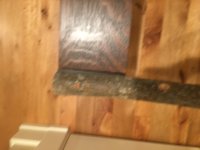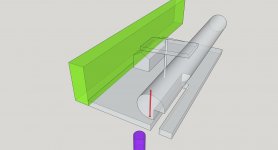I'm working on building 3 night stands that will include rustic hickory elements and match in with some existing craftsman furniture. The legs and lower shelf on each night stand will be hickory and the top casework, including a drawer, will be in QSWO dyed/stained to match the other craftsman furniture in the room. As shown in the photo I need to cut a notch out of each piece of hickory that will be a leg of the night stand. This notch will then attach to a corner of the upper casework (as shown in the slightly blurry photo).
My question is this. I am trying to cut the notch with a Vecturo. It is very slow going. The blade really doesn't want to cut through the hard hickory very well and it produces a lot of smoke (as hickory will do when exposed to friction from a fast moving blade). After the notch is cut there is a decent amount of handwork to clean it up.
Is there a better way to cut this notch? Many of the standard ways I would attack this just don't seem to be practical because the natural shape of a hickory branch doesn't lend itself to woodworking in the same way a piece of dimensioned lumber does.
Also, I had to have the hickory shipped in by freight from Tennessee; which was quite expensive. I purchased a little spare wood in case of a mistake but I really can't afford to make any on this project as ordering replacement wood with another freight charge will be cost prohibitive.
Thanks in advance for the help.
My question is this. I am trying to cut the notch with a Vecturo. It is very slow going. The blade really doesn't want to cut through the hard hickory very well and it produces a lot of smoke (as hickory will do when exposed to friction from a fast moving blade). After the notch is cut there is a decent amount of handwork to clean it up.
Is there a better way to cut this notch? Many of the standard ways I would attack this just don't seem to be practical because the natural shape of a hickory branch doesn't lend itself to woodworking in the same way a piece of dimensioned lumber does.
Also, I had to have the hickory shipped in by freight from Tennessee; which was quite expensive. I purchased a little spare wood in case of a mistake but I really can't afford to make any on this project as ordering replacement wood with another freight charge will be cost prohibitive.
Thanks in advance for the help.



